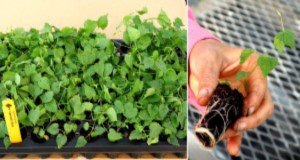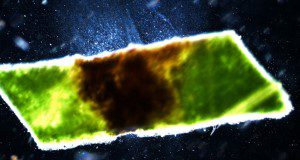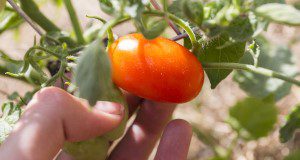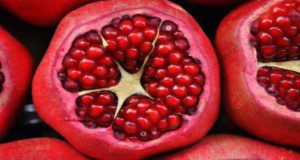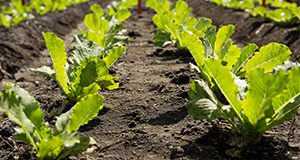This new 13-page article introduces simple image processing and analysis techniques to quantify leaf disease damage using ImageJ, an open-source image processing program. These techniques are not meant to replace crop scouting or disease diagnosis by a plant diagnostic laboratory, but rather to provide a supplemental tool for making quantitative measurements of leaf disease damage. Similar techniques are also available for plant growth assessment, including plant height, plant width, and canopy cover area. The image processing and analysis techniques introduced in this article are fairly simple to use and thus can be adopted not only by researchers, but also by producers, crop consultants, Extension agents, and students. Written by Lillian Pride, Gary Vallad, and Shinsuke Agehara, and published by the UF/IFAS Horticultural Sciences Department.
https://edis.ifas.ufl.edu/hs1382
Tag: Gary Vallad
Selection and Preparation of Planting Material for Successful Hop Production in Florida
Hops (Humulus lupulus L.), an essential ingredient in beer, have potential to develop as a viable alternative crop in Florida. In our surveys, many breweries have expressed strong interest in using locally grown hops. However, hop production is plagued by many diseases, most of which were inadvertently introduced through the movement of contaminated planting material. The primary purposes of this new 7-page article are to prevent the introduction of these diseases into the state and to provide recommendations for selecting and preparing planting material for successful hop production in Florida. This publication of the UF/IFAS Horticultural Sciences Department is part of a larger series that will review the challenges of hop production, based on research experience at the UF/IFAS Gulf Coast Research and Education Center (UF/IFAS GCREC) in Balm, FL.
https://edis.ifas.ufl.edu/hs1381
Integrated Management of Bacterial Spot on Tomato in Florida
Bacterial spot is one of the most detrimental diseases of tomato and is especially severe in the southeast United States when weather conditions (high temperature, high humidity, and rain) become conducive for disease development. This new 8-page publication of the UF/IFAS Plant Pathology Department presents updated information about the causal pathogen and management of bacterial spot on tomato in Florida. Written by Amanda Strayer-Scherer, Ying-Yu Liao, Peter Abrahamian, Sujan Timilsina, Mathews Paret, Tim Momol, Jeff Jones, and Gary Vallad.
https://edis.ifas.ufl.edu/pp353
Target Spot of Tomato in Florida
Fresh-market tomatoes bring in $400-$500 million annually as the third most valuable crop in the state. Defoliation and fruit damage from target spot, caused by Corynespora cassiicola, can have serious economic implications for growers. This new 5-page publication of the UF/IFAS Plant Pathology Department, written by Keevan MacKenzie, Jessica Chitwood, Gary Vallad, and Sam Hutton, reviews symptoms and epidemiology of the disease and provides current management recommendations.
https://edis.ifas.ufl.edu/pp351
Fusarium Wilt (Fusarium oxysporum f. sp. niveum) of Watermelon
Fusarium wilt of watermelon is one of the most serious and difficult diseases to manage and occurs in most production regions worldwide. The fungus can be seedborne and has great longevity in the soil, allowing infested soil to also serve as a source of infection. This new 4-page publication of the UF/IFAS Plant Pathology Department signs, symptoms, and the disease cycle of Fusarium wilt and provides recommendations for cultural and chemical management. Written by Pamela Roberts, Nicholas Dufault, Robert Hochmuth, Gary Vallad, and Mathews Paret.
https://edis.ifas.ufl.edu/pp352
Diseases of Pomegranate (Punica granatum) in Florida
Pomegranate production is becoming increasingly popular in the Southeast. Florida’s humid subtropical to tropical climate is favorable for not only pomegranate tree establishment, but also several diseases. This new 5-page publication of the UF/IFAS Plant Pathology Department, written by Katia V. Xavier, Achala N. KC, and Gary E. Vallad, describes the various diseases affecting pomegranate in Florida and provides some management recommendations.
https://edis.ifas.ufl.edu/pp349
Growing Pomegranates in Florida: Establishment Costs and Production Practices

The study described in this 6-page fact sheet written by Feng Wu, Zhengfei Guan, and Gary Vallad and published by the UF/IFAS Food and Resource Economics Department provides a description of pomegranate production practices and preliminary cost estimates to inform investment and production decisions when growers look to diversify and grow pomegranate as a niche crop.
http://edis.ifas.ufl.edu/fe1024
Organic Management of Vegetable Diseases, Part II: Foliar Pathogens
The successful management of both soilborne and foliar diseases requires a multifaceted program, taking into consideration variety selection, cultural methods, biologicals, and chemical applications approved by the Organic Materials Review Institute (OMRI) and certified organic under the United States Department of Agriculture (USDA) National Organic Program (NOP). This review emphasizes the management of foliar disease and serves as a guide to assist growers in selecting strategies to manage disease in a sustainable system. Written by Gary Vallad and published by the Department of Plant Pathology.
http://edis.ifas.ufl.edu/pp170
Management of Cucurbit Downy Mildew in Florida
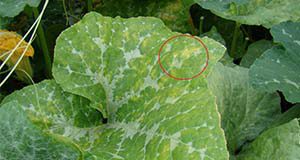
Cucurbit downy mildew is a major disase that affects over 40 species of cucurbits, like watermelon, muskmelon, cucumber, squash, and pumpkin. The classic sign of the disease is the presence of dark sporangia, a structure that holds developing spores, on the underside of infected leaves. As the disease progresses, it may lead to large necrotic areas that cause defoliation and a reduction of yield and marketable fruit. This nine-page fact sheet describes the symptoms and signs, epidemiology and disease cycle, host range and pathotypes, and the ways to manage cucurbit downy mildew. Written by Mason J. Newark, Mathews L. Paret, Nicholas S. Dufault, Pamela D. Roberts, Shouan Zhang, Gary E. Vallad, Josh Freeman, and Gene McAvoy, and published by the Plant Pathology Department.
http://edis.ifas.ufl.edu/pp325
Pest Identification Guide: An Introduction to Thrips
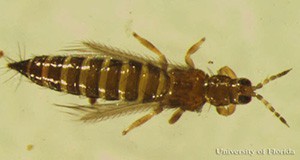 Tiny insects called thrips are difficult to see with the unaided eye but cause very obvious and sometimes ruinous damage to the flowers, buds, and fruit of many important crops. This two-page guide asks and answers the key thrips questions that allow growers to distinguish between chilli thrips, common blossom thrips, and Western flower thrips to more effectively battle against these destructive pests. What does it look like? What is its life cycle? Where is it found? What type of damage does it cause? And, most importantly, who are its natural enemies? Use this guide to help you identify thrips so that you can take effective steps to control them and limit the damage they cause. Written by Nicole Casuso and Hugh Smith with photos by Lyle Buss, Jeff Cluever, Vivek Kumar, P.M.J. Ramakers, Gary Vallad, and Hugh Smith. Published by the Entomology and Nematology Department, UF/IFAS Extension.
Tiny insects called thrips are difficult to see with the unaided eye but cause very obvious and sometimes ruinous damage to the flowers, buds, and fruit of many important crops. This two-page guide asks and answers the key thrips questions that allow growers to distinguish between chilli thrips, common blossom thrips, and Western flower thrips to more effectively battle against these destructive pests. What does it look like? What is its life cycle? Where is it found? What type of damage does it cause? And, most importantly, who are its natural enemies? Use this guide to help you identify thrips so that you can take effective steps to control them and limit the damage they cause. Written by Nicole Casuso and Hugh Smith with photos by Lyle Buss, Jeff Cluever, Vivek Kumar, P.M.J. Ramakers, Gary Vallad, and Hugh Smith. Published by the Entomology and Nematology Department, UF/IFAS Extension.
http://edis.ifas.ufl.edu/in1058
Some Common Diseases of Pepper in Florida
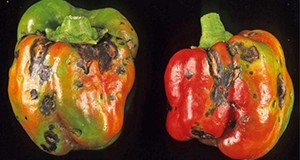
Pepper is an important commercial vegetable crop in Florida. During the months of November through May, the country is dependent on Florida for its supply of domestic fresh peppers. But disease problems often limit Florida pepper production. This fact sheet describes the symptoms and provides control recommendations for bacterial spot, phytophthora blight, wet rot, cercospora leaf spot, southern blight, blossom end rot, tobacco mosaic virus, aphid-transmitted viruses, and tomato spotted wilt virus (TSWV). Written by Gary Vallad, Pamela Roberts, Ken Pernezny, and Tom Kucharek. Originally published by the UF Department of Plant Pathology in March 1991, Revised September 2015. (Photo credit: Gerald Holmes, Bugwood.org, CC BY-NC 3.0 US). We would like to extend special thanks to professors emeriti Ken Pernezny and Tom Kucharek for interrupting their shuffleboard schedules to contribute to the revision of this publication.
http://edis.ifas.ufl.edu/vh054
The Good, the Bad, and the Ugly: What the Future Could Hold for Bs2 Tomatoes
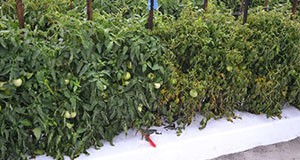 Bs2 tomatoes are transgenic tomatoes that have been engineered to contain the Bs2 gene from pepper. As such, they are considered a genetically modified (GM) food, or a genetically modified organism (GMO). Numerous trials conducted by University of Florida researchers have shown the benefits of these cultivars for bacterial spot disease management, and growers and industry members recognize the potential for Bs2 tomatoes to make Florida tomato production more sustainable. This 4-page fact sheet discusses the benefits that might be realized by the adoption of Bs2 tomato varieties, and the challenges standing in the way of their commercial production. Written by S. F. Hutton, J. W. Scott, J. B. Jones, R. E. Stall, G. E. Vallad, B. J. Staskawicz, and D. M. Horvath , and published by the UF Department of Horticultural Sciences, April 2015.
Bs2 tomatoes are transgenic tomatoes that have been engineered to contain the Bs2 gene from pepper. As such, they are considered a genetically modified (GM) food, or a genetically modified organism (GMO). Numerous trials conducted by University of Florida researchers have shown the benefits of these cultivars for bacterial spot disease management, and growers and industry members recognize the potential for Bs2 tomatoes to make Florida tomato production more sustainable. This 4-page fact sheet discusses the benefits that might be realized by the adoption of Bs2 tomato varieties, and the challenges standing in the way of their commercial production. Written by S. F. Hutton, J. W. Scott, J. B. Jones, R. E. Stall, G. E. Vallad, B. J. Staskawicz, and D. M. Horvath , and published by the UF Department of Horticultural Sciences, April 2015.
http://edis.ifas.ufl.edu/hs1259
Integrated Pest Management in Protected Structures I: Basic Principles and Scouting
 The fundamentals of managing pests in protected structures are very similar in many respects to managing pests in field crops. But conditions within a protected structure can be modified to a certain degree to prevent, delay, or even mitigate pest issues. On the other hand, conditions that discourage one group of pests can often favor another. This 7-page fact sheet was written by Hugh A. Smith, Gary E. Vallad, and Bielinski M. Santos, and published by the UF Department of Entomology and Nematology, June 2013.
The fundamentals of managing pests in protected structures are very similar in many respects to managing pests in field crops. But conditions within a protected structure can be modified to a certain degree to prevent, delay, or even mitigate pest issues. On the other hand, conditions that discourage one group of pests can often favor another. This 7-page fact sheet was written by Hugh A. Smith, Gary E. Vallad, and Bielinski M. Santos, and published by the UF Department of Entomology and Nematology, June 2013.
http://edis.ifas.ufl.edu/in994
Protected Culture for Vegetable and Small Fruit Crops: Types of Structures
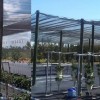 A protective structure is defined as any structure designed to modify the environment in which plants are grown. Protective structures, such as greenhouses, screen houses, and tunnels, are known worldwide as production systems for high-quality vegetable and fruit crops. This 4-page fact sheet was written by Bielinski M. Santos, Gary Vallad, and Emmanuel A. Torres-Quezada, and published by the UF Department of Horticultural Sciences, July 2013.
A protective structure is defined as any structure designed to modify the environment in which plants are grown. Protective structures, such as greenhouses, screen houses, and tunnels, are known worldwide as production systems for high-quality vegetable and fruit crops. This 4-page fact sheet was written by Bielinski M. Santos, Gary Vallad, and Emmanuel A. Torres-Quezada, and published by the UF Department of Horticultural Sciences, July 2013.
http://edis.ifas.ufl.edu/hs1224
HS1180 Cultural Practices for Vegetable and Small Fruit Crops: Does Shoot Pruning Improve Tomato Yield and Reduce Bacterial Spot Infestation?
HS1180, a 4-page illustrated fact sheet by Bielinski M. Santos and Gary E. Vallad, examines the effectiveness of shoot pruning to control bacterial spot infestation and improve yield of tomato. Published by the UF Department of Horticultural Sciences, July 2010.
http://edis.ifas.ufl.edu/hs1180
PP272 Integrated Management of Southern Blight in Vegetable Production
PP272, a 6-page illustrated fact sheet by Chenzhao Xie and Gary Vallad, guides vegetable growers to recognize and manage this serious fungal disease affecting diverse crops grown around the world, especially in tropical and subtropical regions — symptoms and signs, pathogen biology, disease cycle, epidemiology and integrated management. Includes references. Published by the UF Department of Plant Pathology, March 2010.
http://edis.ifas.ufl.edu/pp272
PP200/PP121: A Series on Diseases in the Florida Vegetable Garden: TOMATO
Revised! PP200, an 8-page illustrated fact sheet by Gary Vallad, Ken Pernezny, and Tim Momol, describes several diseases most likely to appear on garden tomatoes in Florida, providing information for identification and management for each. Published by the UF Department of Plant Pathology, February 2009.
http://edis.ifas.ufl.edu/pp121
ENH1121/EP380 Disinfection of Horticultural Tools
ENH-1121, a 2-page fact sheet by Geoffrey C. Dennny and Gary E. Vallad, provides assistance to producers and home gardeners in selecting the appropriate method to sterilize or disinfect horticultural tools and implements and prevent the spread of disease-causing pathogens. Published by the UF Department of Environmental Horticulture, August 2009.
http://edis.ifas.ufl.edu/EP380
PPP6/PG100 2008 Florida Plant Disease Management Guide: Chemical Control Guide for Diseases of Vegetables, Revision No. 19
Revised! PPP-6, a 108-page publication by Ken Pernezny, Amanda Gevens, Tim Momol, Aaron Palmateer, Natalia Peres, Richard Raid, Pam Roberts, Gary Vallad, and Shousan Zhang, is a guide to lawful use of sprayable chemicals intended for control of plant diseases affecting vegetables grown in Florida. Published by the UF Department of Plant Pathology, September 2008.
http://edis.ifas.ufl.edu/PG100
PP259 Tomato Purple Leaf Disorder: A New Challenge for the Tomato Industry in Florida
PP259, a 2-page illustrated fact sheet by Gary E. Vallad, Bielinski M. Santos, Jane E. Polston, David J. Schuster, Andrew W. MacRae, Jeremy D. Edwards, and John W. Scott, describes this disorder, TPLD, observed in tomato fields in Hillsborough, Manatee, and Miami-Dade counties since 2006 — symptoms and field distribution, and the state of current research into the disorder. Published by the UF Department of Plant Pathology, November 2008.
http://edis.ifas.ufl.edu/PP259

